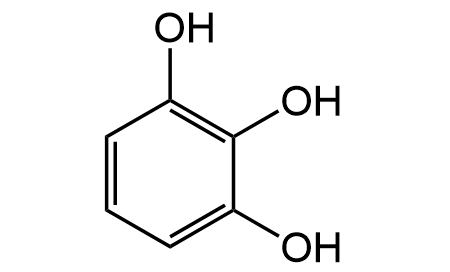
Chemical Structure
Pyrogallol
CDX-Y0964
CAS Number87-66-1
Product group Chemicals
Estimated Purity>99%
Overview
- SupplierChemodex
- Product NamePyrogallol [87-66-1]
- Delivery Days Customer10
- CAS Number87-66-1
- CertificationResearch Use Only
- Estimated Purity>99%
- Scientific DescriptionChemical. CAS: 87-66-1. Formula: C6H6O3. MW: 126.11. The Polyphenol pyrogallol is a powerful naturally occuring reducing agent. Due to its oxygen radical generating property, pyrogallol is commonly used as a photographic developing agent, in hair dying industry, as an antiseptic and to calculate the amount of oxygen in the air. Pyrogallol is a potent superoxide anion (O2 -) generator. Pyrogallol causes oxidative damage and induces mutagenesis, carcinogenesis and hepatotoxicity. It impairs immune responses, inhibits phagocytosis and suppresses the proliferation due to its strong free radical generating potential. As a superoxide generator it is commonly used to investigate the role of free radicals in the biological system. It is a potent inducer of Nrf2-mediated gene expression. Pyrogallol possesses anti-bacterial, anti-fungal, anti-psoriatic anti-cancer, anti-inflammatory and neuroprotective properties. Pyrogallol induces apoptosis in lung cancer cells via the overproduction of O2 - and affects mitogen activated protein kinases (MAPKs). Pyrogallol exerts antitumor effects via S-phase arrest and inhibition of PI3K/AKT/Skp2/cMyc signaling. Pyrogallol is a neuroprotective compound shown to work as dual modulators for the treatment of AD by inhibiting aggregation or promoting dissociation of Abeta and tau. Pyrogallol is an anti-biofilm agent. It reduces biofilm formation in S. aureus and S. epidermidis in a mechanism involving induction of bacterial oxidative stress. Pyrogallol can be used as an organic building block or intermediate for synthesis of different types of sensors (for colorimettic detection) or other biological active compounds (e.g. antivirals). It is also used as a metal-complexing agent. - The Polyphenol pyrogallol is a powerful naturally occuring reducing agent. Due to its oxygen radical generating property, pyrogallol is commonly used as a photographic developing agent, in hair dying industry, as an antiseptic and to calculate the amount of oxygen in the air. Pyrogallol is a potent superoxide anion (O2 -) generator. Pyrogallol causes oxidative damage and induces mutagenesis, carcinogenesis and hepatotoxicity. It impairs immune responses, inhibits phagocytosis and suppresses the proliferation due to its strong free radical generating potential. As a superoxide generator it is commonly used to investigate the role of free radicals in the biological system. It is a potent inducer of Nrf2-mediated gene expression. Pyrogallol possesses anti-bacterial, anti-fungal, anti-psoriatic anti-cancer, anti-inflammatory and neuroprotective properties. Pyrogallol induces apoptosis in lung cancer cells via the overproduction of O2 - and affects mitogen activated protein kinases (MAPKs). Pyrogallol exerts antitumor effects via S-phase arrest and inhibition of PI3K/AKT/Skp2/cMyc signaling. Pyrogallol is a neuroprotective compound shown to work as dual modulators for the treatment of AD by inhibiting aggregation or promoting dissociation of Abeta and tau. Pyrogallol is an anti-biofilm agent. It reduces biofilm formation in S. aureus and S. epidermidis in a mechanism involving induction of bacterial oxidative stress. Pyrogallol can be used as an organic building block or intermediate for synthesis of different types of sensors (for colorimettic detection) or other biological active compounds (e.g. antivirals). It is also used as a metal-complexing agent.
- Storage InstructionRT
- UNSPSC12352200

![Pyrogallol [87-66-1]](https://www.targetmol.com/group3/M00/02/5E/CgoaEWY7K2yEIIPaAAAAAC-idSs665.png)